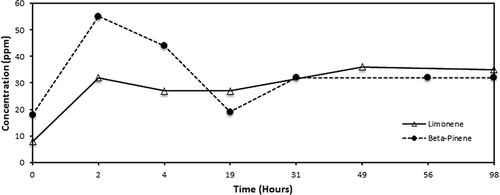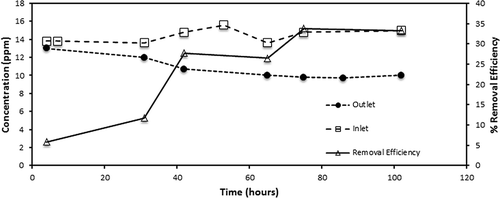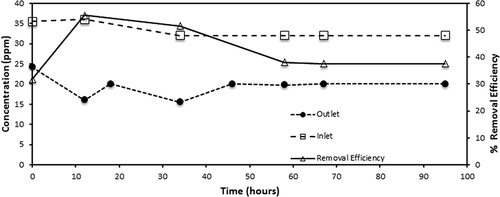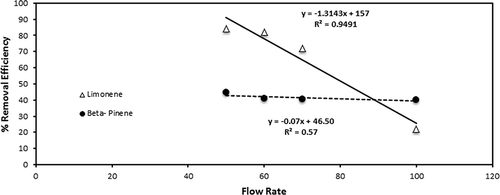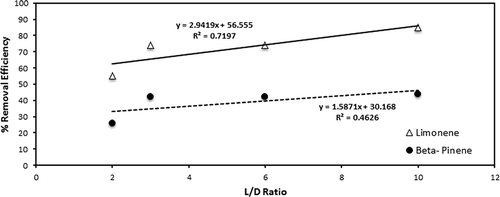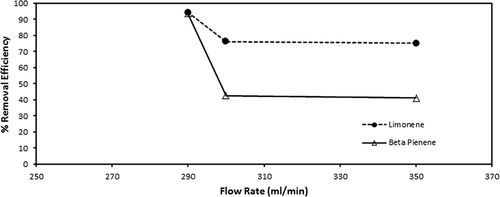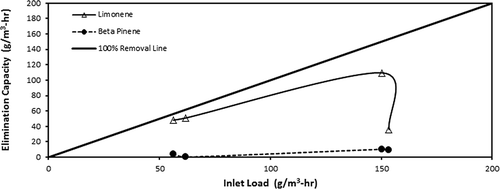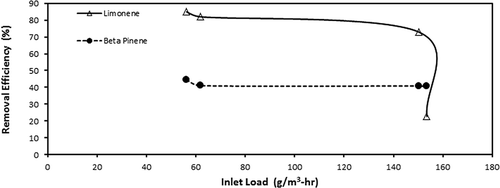Abstract
Composting is widely used for the treatment of solid organic wastes; however, emissions from composting are becoming a threat to humans due to the release of toxic volatile organic compounds (VOCs). VOCs from composting operations are characterized by high flow rates and, normally, low pollutant concentration. Typical VOCs include a large amount of terpenes (∼65% of total VOCs). This study was to investigate the efficiency of biofiltration in controlling terpene emissions from composting operations using a laboratory-scale unit. The performance of a biofilter was investigated as a function of inlet flow rate, inlet concentration, and bed length/bed diameter (L/D) ratio of bed. At the lowest total inlet flow rate, removal efficiency of limonene and β-pinene was more than 90%. With the decrease in inlet concentration and increase in L/D ratio, the removal efficiency was effectively increased. Removal efficiency of more than 85% for Limonene and 45% for β-Pinene was attained at a loading rate of 55 g/m3-hr. The maximum elimination capacity was found for 109.7 g/m3-hr for limonene and 10.3 g/m3-hr for β-pinene at a critical loading of 150.1 g/m3-hr. Based on this study, the compost bed could function as a biofilter for controlling terpene odors during the composting process.
The purpose of this research project is to investigate the efficiency of biofiltration in controlling limonene and β-pinene emissions from composting operations using a laboratory scale. In addition, the performance of a biofilter as a function of inlet flow rate, inlet concentration, and L/D ratio of bed was evaluated. Establishing a nexus between the operational parameters and efficiency would be useful in design and operation of compost bed as a biofilter for controlling terpene odors during the composting process.
Introduction
Composting is widely used for the treatment of solid organic wastes. It reduces waste in size and volume. California disposes an estimated 42 million tons of waste in landfills each year, consisting of approximately 30% compostable organic materials, 22% construction and demolition debris, and 21% paper (CitationHorowitz, 2008). Composting operation is becoming a threat to humans due to the release of toxic volatile organic compounds (VOC) emissions. VOCs from composting operations are characterized by high flow rates and, normally, low pollutant concentration (CitationEstela et al., 2006). Typically, these VOCs are odorous and have hazardous properties. These compounds mix with other chemicals in the air to produce ground-level ozone, thus contributing to global warming.
CitationDefoer et al. (2002) identified 89 different chemical compounds in emissions arising from vegetable, fruit, and garden (VFG) composts. Terpenes are the most prevalent VOCs emitted from yard wastes, followed by aromatic hydrocarbons, ketones, and alkanes (CitationDimitris, 2004). Terpenes occur widely in vegetation, are a major contributor to the fragrance of plants, can be found in concentrations ranging between 0 and 500 ppb, and their odor threshold is 6 ppb (CitationWilber and Murray, 1990). Terpenes contribute to about 65% of total VOC concentration, followed by 8% ketones, 8% hydrocarbons, 7% alcohols, 5% esters, 3% aldehydes, and 3% sulfur compounds. Typical terpenes from composting include limonene, α, β-pinene, camfene, γ-terpinene, terpinolene, and thujone (CitationPark et al., 2002). There are some published research papers on the control of terpene compounds such as limonene and β-pinene. However, the performance of the biofiltration system was not characterized with regard to operating and design variables. The objective of this research is to investigate whether a compost bed could function as a biofilter for controlling terpene odors during the landfill operation, and if so, to study the efficiency of commonly found terpenes, namely, limonene and β-pinene, in biofiltration from composting operations as a function of process variables using a laboratory scale unit.
Literature Review
The VOC emissions from composting operations, along with the odor, can be eliminated using various methods like water flushing, incineration, air dilution, and biofiltration (CitationPark et al., 2002). The crucial step in all composting process is the activity of microorganisms to break down the solid organic matter through aerobic or anaerobic decomposition. To convert biowaste into compost, the aerobic process is primarily considered (CitationDevinny et al., 1999). Biofiltration involves basic two steps, namely, the flow of contaminated or odorous gas emissions through a biologically enriched layer of packing material or bed, and the biodegradation of adsorbed or absorbed pollutants (CitationLiu et al., 2009). Degradation of toxic pollutant in a biofilter is influenced by a number of factors, the most important of which is the bed for the support and growth of microbial biofilm in the compost substrate. The materials used on the bed include wood chips and bark, peat, soil and mixtures, activated carbon, lava rock, and synthetic organic materials.
CitationKleinheinz et al. (1999) conducted a study to isolate and characterize monoterpene-degrading microorganisms and apply them to a biofiltration unit for use in degrading high levels of α-pinene. The researchers achieved more than 90% complete degradation of α-pinene in 36 hr with a maximum rate of degradation of 3.9 mg/L/hr at concentrations averaging 295 ppm and with an influent loading of greater than 30 g/m3/hr.
The emissions from composting plants produce complex mixtures of terpene compounds, which are odorous. These are mainly released at the initial stages of the composting process. CitationPagans et al. (2006) identified that the most important indicator of the composting process performance is the bed temperature. For maximum biodegradation, bed temperatures of 45–55°C must be maintained. During the active life of the biofilter, the microorganism acclimatization to the contaminant is an important factor for efficient biofilter operation (CitationBoswell, 2004). CitationDimitris et al. (2004) conducted a laboratory experiment of municipal solid waste (MSW) composting using airtight stainless-steel digesters with varying temperatures. Several xenobiotic VOCs emitted during composting of simple MSW components, such as food wastes, mixed paper, and yard wastes, indicated that industrial wastes or other hazardous wastes are not the sole producers of such VOCs in mixed MSW. According to Dimitris et al., food waste produced mainly sulfide compounds, followed by acids, alcohols, and terpenes; α-pinene and limonene were the typical terpenes emitted from yard waste as a result of microbial process.
Biofilter materials, design of the biofilter, and its operation are the main parameters influencing the efficiency of biofilters. CitationElias et al. (2002) referred to the filter bed or packing material as the “heart” of a biofiltration system, which provides a nutrient source, a method of attachment for microorganisms and, frequently, its own microbial population. According to Elias et al., the main characteristics of the filter bed include the following: (1) high moisture retention capacity, (2) high porosity and high buffer capacity, (3) high available nutrient content, (4) a diverse and adaptable microbial population, (5) low cost, and (6) long life. Recent research work on design parameters used in the analysis of odorous emission compounds from composting operations is summarized in .
Table 1. Design parameters used in other similar studies from composting operations
CitationDirk-Faitakis et al. (2003) investigated the biofiltration of periodically fluctuating concentrations of α-pinene-laden waste gas to treat both high-frequency and low-frequency fluctuations. The effects of periodic concentration fluctuations on biofilter performance were measured. CitationLi et al. (2003) conducted a two-stage biofiltration system experiment with a rusty iron reactor followed by a conventional biofilter to remove H2S and methyl ethyl ketone (MEK) from an air stream. They used an experimental unit consisting of Plexiglas biofilter columns with an internal diameter of 5 cm and a height of 50 cm, and they used compost for the filter bed. They identified different MEK concentration at the exit due to minor variation in the packing of compost. They also found that the bed becomes more acidic with the production of sulfuric acid as a result of biodegradation of H2S and that this influenced the MEK biodegradation bacteria.
CitationSchlegelmilch et al. (2005) determined terpene compounds such as α-pinene, camphene, β-phellandrene, β-pinene, β-myrcene, 3-carene, limonene, and others in waste gas from composting process. They presented odor reduction efficiencies of biological waste gas treatment systems at various scales by carrying out experiments with a combination of different biofilter materials. The experimental unit was designed to treat a maximum amount of 1000 m3/hr of waste air. The experiment revealed that screened compost was very effective, and proved to be a low-cost biofilter material for odor degradation purposes and showed higher degradation rates than a coke–compost mixture.
CitationMorgan and Noyola (2006) investigated the effect of mixing the filter materials in a compost biofilter on H2S removal efficiency. The compost had a carbon/nitrogen ratio of 20:1, a moisture content of 65%, a pH of 7.48, an alkalinity of 357 mg (as CaCO3) per liter, a real and apparent density of 1.1 and 0.59 g/mL, respectively and a void fraction of 46%. With airflow rate maintained at 10 L/min, and empty bed residence time (EBRT) of 50 sec, they reported that H2S removal capacity decreased from 100% to 90% over time, but when bed mixing was carried out, the removal capacity remained constant, close to 100%.
Jeong et al. (2006) conducted research to assess the efficiency complex odoriferous compounds using one- or two-stage biofiltration systems by testing the single odor gases limonene, α-pinene, and isobutyl alcohol. Both limonene and α-pinene were removed at 90% or more elimination capacity (EC), 364 g/m3/hr and 321 g/m3/hr, respectively, at an input concentration of 50 ppm and a retention time of 30 sec. CitationJin et al. (2006) conducted a biokinetic study using α-pinene-polluted air in a biofilter. They observed up to a load of 100 g/m3/hr1, with 89% removal efficiency. They evaluated influence of gas flow rate, pollutant concentration, and load. For a similar load, they observed the highest removal efficiency and corresponding elimination capacity at the lowest flow rate with oxygen had a significant effect on the removal efficiency. CitationChung (2007) studied a biofilter system to purify the exhaust air from compost operations. The biofilter was packed with mature compost mixed with activated carbon and sludge sourced from a wastewater treatment plant and the experiment was run for 150 days. The gas flow rate was maintained at 20.34 L/min, corresponding with an EBRT of 30 sec. They were also able to demonstrate the efficiency of the biofilter by maintaining the moisture content constant.
CitationLiu et al. (2009) conducted a comprehensive an in situ compost biofilter study for odors from biostabilization processing of municipal solid waste. They tested 40 different chemical compounds including the most prominent groups such as alkylated benzenes, followed by alkanes, alkenes, terpenes, and sulfur compounds. The compost biofilter showed remarkable removal ability for alkylated benzenes but poor performance for terpenes, including negative efficiencies. The reasons for negative efficiencies were unexplained.
From the preceding review, it is clear that the biofiltration of emissions emanating from composting operation could result in the degradation of odorous compounds provided appropriate process conditions are maintained. Most of these biofilters were not made using compost materials from typical landfill operation and hence cannot duplicate typical landfill site and associated conditions. In addition, there are no process-based published data on terpene biofiltration using compost. This paper presents a detailed design and experimental verification of a biofilter to control terpene emissions from a typical landfill composting operation.
Methodology
Laboratory-scale biofiltration system
A laboratory-scale biofilter system was designed for analyzing the emissions from composting operations. The laboratory-scale unit includes air supply to the biofilter, mass flow controllers, terpene spiking station, biofilter column, and a gas chromatography/surface acoustic wave analyzer, termed the GC/SAW (CitationStaples and Viswanathan, 2008). A schematic of the lab-scale experimental setup is shown in
Biofilter column design
The biofilter columns were constructed from transparent polyvinyl chloride pipe, with four different length/diameter (L/D) ratios, namely, 10, 6, 3, and 2, respectively (D = 2.54 cm, L = 25.4 cm; D = 2.54 cm, L = 15.24 cm; D = 8.38 cm, L = 26.7 cm; and D = 8.38 cm, L = 17.0 cm). These ratios are within the ranges found from the literature ().
Experiments were conducted to study the background emissions by the obiofilter itself, as it constitutes compost and (10%) wood shavings. Since most of the compost columns reviewed in the literature () for pinene had close to a 1:3 ratio for diameter to length, the column chosen for this study had a height to diameter ratio of 3.2. In this work, compost material mixed with 10% (weight basis) wood shavings was selected as the filter bed, duplicating a typical compost operation.
Flow rate
The airflow rate and empty bed residence time (EBRT) have a significant impact on the biodegradation performance and overall efficiency of the biofilter. The airflow rate, Q, and the empty bed residence time, τ, are given by the following equation:
Moisture content
Moisture content is one of the predominant characteristics of the filter bed in biofiltration. It aids the microbial activity in the biofilm. With a low-moisture-content bed, desiccation and gas flow channeling take place and, ultimately, affect the microflora. A high percentage moisture content results in bed compaction due to the reduction in specific area for gas exchange and formation of anaerobic zones. Pagnas et al. (2006) studied an experiment with a moisture content ranging from 40 to 60%, which was found to be effective in removing emissions of VOCs from composting operations of different solid wastes. CitationChung (2007) suggested moisture content must be maintained between 40% and 60% in the biofilter to maintain biological activity.
Temperature
Microbial growth in the filter material depends on the temperature. Mesophilic temperature ranging between 20 and 40°C is most commonly found in the filter for the improved microbial growth. Variation in temperature also affects the biodegradation reaction due to the microbial activity.
pH
Biofilter performance is often pH sensitive. CitationBarona et al. (2004) suggested that maintaining a fairly constant and neutral pH value will give better biofilter performance.
Compost biofilter performance evaluation
The performance of the compost biofilter in this work was evaluated by the following performance parameters: inlet load (g/m3-hr), elimination capacity (g/m3-hr), and removal efficiency (%). The definitions for these parameters are:
Description of compost
Garden waste compost used in this experiment was obtained from Miramar Landfill, San Diego, CA. Compost was characterized according to the Test Methods for Evaluation of Compost and Composting (http://compostingcouncil.org/tmecc, accessed September 17, 2012). The particle size distribution was analyzed using sieve analysis and the results are shown in . Moisture content was analyzed using an Ohaus moisture analyzer (MB45) at 85°C.
Table 2. Particle size distribution of compost
The properties of the compost bed at the start are:
| • | Moisture content: 33.5% (±1%) by weight. | ||||
| • | pH: 5.55–5.70. | ||||
| • | Bulk density: 334 g/L (±10 g/L). | ||||
| • | Particle size distribution: as listed in . | ||||
Chromatographic analysis
A zNose model 4300 gas chromatograph (GC) was used to analyze the VOCs instantaneously. The GC employs a trap and helium carrier gas, by injecting samples into a heated column where separation is achieved. The measuring crystal vibrates at high frequency, which is measured by the analyzer circuitry. The output of the column is directed against the crystal where the sample is deposited on the surface. The crystal vibrates at a lower frequency when the material is deposited on the surface. The frequency of the crystal is subtracted (mixed) with a fixed oscillator to give a difference frequency called the intermediate frequency (IF). This frequency changes in direct proportion to the amount of material deposited on the crystal and is processed by the system controller (CitationStaples and Viswanathan, 2008). This gas chromatograph was fitted with a 3-m capillary column. The oven temperature of the GC was maintained at 40°C with the carrier gas flow of 3 cm3/min. The GC was precalibrated using calibration standards prepared using a known amount of terpene compounds injected into a 500-mL calibration flask. Terpene compounds were identified by injecting a known standard and comparing with published literature or a predetermined Kovats retention index data.
Experimental procedure
Two terpenes, limonene and β-pinene, were chosen for this study. The properties of the terpene compounds (limonene and β-pinene) are given in . The biofilter materials were first allowed to acclimatize for several weeks, by passing air at a flow rate of 250 mL/min laden with the terpene compounds. The terpenes were loaded into the air stream by bubbling air through the liquid compounds (98% purity) present in a bubbling unit. The lab temperature was at 25°C. The biofilter materials were moistened while filling the biofilter column and tapped regularly in order to achieve a stable pack and eliminate voids. A desired moisture content level of 50–60% was achieved and maintained by bubbling a portion of the influent gas stream through a humidification unit to saturate it. Periodically, water was also added by means of a spray nozzle at the top of the packing material to maintain the required moisture content. The humid air and terpene-saturated air streams were mixed and the combined stream was fed to the biofilter. The concentration of the terpenes in the feed stream was controlled by varying the airflow rate through the terpene bubbling unit. The flow rates were adjusted using Aalborg mass flow controllers. The inlet and outlet concentrations of the biofilter were measured at regular intervals using a GC/SAW system. The measurements points had sampling ports that were directly connected to the GC/SAW system for direct injection and analysis. This fast GC/SAW system was essential in getting accurate data quickly. Each measurement point was sampled at least three times and the averages of data obtained were used further analysis. The performance of biofilter was investigated as a function of inlet flow rate, L/D ratio of bed, and inlet concentration.
Table 3. Properties of terpene compounds used
Results and Discussion
The biofilter performance of emissions of the most predominant terpenes, namely, limonene and β-pinene, were evaluated in a laboratory-scale unit.
General compost emissions
shows the results observed during the study of background emissions of the most prevalent terpenes, namely, limonene and β-pinene. The results showed that the highest concentration of terpenes in the effluent gas stream was detected during the first 24 hr of processing time. Limonene and β-pinene emissions showed a similar emission trend after reaching a stabilization point with an equilibrium concentration of 30–35 ppm during a 4-day run. The initial high emissions of both the terpenes can be explained due to the presence of the wood shavings, which emitted most of the terpenes during the initial few days. With time, the shavings were inoculated with microorganisms from the compost, which resulted in the shavings getting composted and thereby in reduced emissions.
Effect of inlet flow rate
The influent and effluent gas concentrations of β-Pinene are shown in through for different inlet flow rates. The experiment was carried out with compost column of bed diameter 2.54 cm and length 25.4 cm, for a constant total inlet flow rate of 300 mL/min and with 50, 60, 70, and 100 mL/min of terpene flow. This column gave consistent results with minimal variation and hence was used in these set of experiments. Hourly variations of β-pinene in influent and effluent gas streams of compost biofilter can be clearly observed in these figures. In addition, the removal efficiency is plotted as a function of time. These data reveal that during the initial period of 24 hr, a steadily increasing concentration of both terpene compounds in the effluent gas stream was observed, thus indicating poorer performance (lower removal efficiency). However, after 24 hr, a stabilized steady decrease in β-pinene concentrations (higher removal efficiencies) was observed in the effluent gas streams, indicating the effectiveness of the biofilter. This somewhat poor performance at the beginning of the cycle may have resulted from an operational standpoint because there are always other factors (like moisture and temperature variations) that can cause variations in biofilter performance. Similar observations were seen in limonene degradation. During the total operation time of 5 days, about 80% removal of limonene and about 40% of β-pinene was achieved at 50 mL/min inlet flow rate.
represents the relationship between percentage removal and flow rate. The experiments were run with a biofilter compost column of bed diameter 2.5 cm and length 25.4 cm, for a constant total inlet flow rate of 300 mL/min with individual limonene and β-pinene flow rates of 50, 60, 70, and 100 mL/min of terpene flow. At the terpene inlet flow rate 50 mL/min, 85% limonene and 44.6% β-pinene removal efficiencies were observed, and this flow showed the highest removal efficiency. As the inlet flow rate was increased, the efficiencies were observed to decrease more or less linearly for both compounds. At 100 mL/min flow rate, removals of 22.7% limonene and 40.6% β-pinene were detected. Since lower flow rates increase the residence times, higher removal efficiencies can be expected due to less contact between the chemicals and microbes.
Effect of L/D ratio
shows the effect of L/D ratio on the percentage removal efficiency. The entire experiment was carried out in four different biofilter columns, D = 2.5 cm, L = 25.4 cm; D = 2.5 cm, L = 15.2 cm; D = 8.4 cm, L = 26.7 cm; and D = 8.4 cm, L = 17.0 cm, for a total flow rate of 300 mL/min. The L/D ratios were 10, 6, 3, and 2 respectively.
At an L/D ratio of 10, highest removal efficiencies of 85% for limonene and 44.6% for β-pinene removal were observed, followed by 75.4% limonene and 42.9% β-pinene removal efficiencies with L/D of 6. With an L/D ratio of 2, 54.9% limonene and 26.1% β-pinene was obtained. From these results, it is clear that the increase in L/D ratio, increases the removal efficiency due to higher contact times.
Effect of inlet concentration
As mentioned in the Methodology section, the concentration of the contaminant in the influent stream is controlled by the flow rate of air through the terpene bubbler. Higher flow rates of air through the bubbler caused higher vaporization rates and hence higher concentrations of terpenes. summarizes the effect of inlet concentration on the removal efficiencies. The experiment was run with inlet flow rates of 290, 300, and 350 mL/min in a biofilter column of bed diameter 8.38 cm and bed length 26.7 cm.
At the lowest inlet concentration with flow rate of 290 mL/min, 94.3% limonene removal and 93.7% β-pinene removal were observed in the biofilter. With total inlet flow rate of 300 mL/min, lower removals of 76.2% for limonene and 42.7% for β-pinene were observed. As the total inlet flow rate was further increased to 350 mL/min, 75.2% limonene and 41.2% β-pinene were obtained. Thus, it can be observed from that with the decrease in the inlet concentration, removal efficiency can be increased, similar to an observation made by Jeong et al. (2006).
Compost biofilter performance evaluation
Elimination capacity
The elimination capacities of β-pinene and limonene at four different loading rates are presented in The laboratory-scale biofilter used in this study had a volume of 129 cm3 and L/D ratio of 10. The relationship was linear up to a critical value, after which the elimination capacity reached a maximum value of 110 and reduced with inlet loading. With the increase in inlet concentration, the elimination capacity of the bed is reduced as a result of the availability of limited oxygen.
Figure 9 indicates that the maximum elimination capacity of β-pinene and limonene studied in this work using a compost biofilter are 109.7g/m3-hr for limonene and 10.3 g/m3-hr for β-pinene and the critical load is 150.1 g/m3-hr. In a similar compost biofilter study, CitationPagans et al. (2006) showed a maximum elimination capacity of 119.5 g/m3-hr for pinene. A similar observation was made by CitationJin et al. (2006) in their research work on fungal biodegradation of α-pinene in gas biofilter. The results here demonstrate that efficiencies obtained were highly dependent on the loading rate and on the type of terpene compound emitted during composting.
Removal efficiency
shows the influence of β-pinene and limonene at four different loading rates on the removal efficiency. The laboratory-scale biofilter used in this part of the study had a volume of 129 cm3 and L/D ratio of 10. As inlet load increased from 55 to150 g/m3-hr, removal efficiency decreased from 85% to 20% for limonene and from 45% to 40% for β-pinene. It can be deduced from these results that removal efficiency is the highest at 85% for limonene and 45% for β-pinene at the lowest loading rate of 55 g/m3-hr for terpene. This is expected, considering that the lowest loading rate requires less oxygen and hence higher removal efficiency. These results also demonstrate that limonene is more readily biodegradable than β-pinene.
Conclusion
In this work, the removal of terpene compounds, namely, limonene and β-pinene, using a compost biofilter was studied. The three parameters studied include the effect of total inlet flow rate, total inlet concentration, and L/D effect for limonene and β-pinene, respectively. The study also involved the evaluation of the performance of the compost biofilter in terms of elimination capacity and removal efficiency.
The overall conclusions from this study can be summarized as the following:
| • | The effect of flow rate study showed 85% limonene and 44.6% β-pinene removal efficiency at 50 mL/min flow rate. | ||||
| • | At the lowest inlet concentration with inlet flow rate of 290 mL/min, above 90% of highest removal efficiency was observed for both limonene and β-pinene. | ||||
| • | At L/D of 10, highest removal efficiencies of 85% limonene and 44.6% β-pinene removal were observed. | ||||
| • | For loading rate of 55 g/m3-hr, removal efficiency over 85% for limonene and 45% for β-pinene were attained. | ||||
| • | The maximum elimination capacity was determined to be 109.7g/m3-hr for limonene and 10.3 g/m3-hr for β-pinene at the critical loading of 150.1 g/m3-hr. | ||||
Experimental analysis indicated that the biofiltering properties investigated with effect of inlet flow rate, inlet concentration, and L/D ratio showed improved removal efficiency for limonene and β-pinene under controlled parameters. Finally, it can be concluded that the biofiltration has a relevant value for the control of terpenes such as limonene and β-pinene emanating from composting operations.
Acknowledgment
The authors acknowledge the help provided by Shashi Gajaraj on the experimental set up, and by Harsha Viswanathan in revising the figures.
References
- Barona , A. , Elías , A. , Arias , R. and Canoi , R. 2004 . Biofilter response to gradual and sudden variations in operating conditions . Biochemical Engineering Journal , 22 ( 1 ) : 25 – 31 . doi: 10.1016/j.bej.2004.07.006
- Boswell , J. 2004 . Compost based biofilters control air pollution . BioCycle , 45 ( 1 ) : 42 – 46 .
- Chung , Y.C. 2007 . Evaluation of gas removal and bacterial community diversity in a biofilter developed to treat composting exhaust gases . Journal of Hazardous Materials , 144 ( 1–2 ) : 377 – 385 . doi: 10.1016/j.jhazmat.2006.10.045
- Defoer , N. , De Bo , I. , Van Langenhove , H. , Dewulf , J. and Van Elst , T. 2002 . Gas chromatography–mass spectrometry as a tool for estimating odour concentrations of biofilter effluents at aerobic composting and rendering plants . Journal of Chromatography A. , 97 ( 1–2 ) : 259 – 273 . doi: 10.1016/S0021‐9673(02)00654‐4
- Devinny , J.S. , Deshusses , M.A. and Webster , T.S. 1999 . Biofiltration for Air Pollution Control , Boca Raton , FL : Lewis .
- Dimitris , K. P. , Ham , R.K. and Park , J.K. 2004 . Emission of volatile organic compounds during composting of municipal solid wastes . Water Research , 38 ( 7 ) : 1707 – 1714 .
- Dirk-Falktakis , C. and Allen , D.G. 2003 . Biofiltration of cyclic air emissions of α pinene at low and high frequencies . J. Air & Waste Manage. Assoc. , 53 : 1373 – 1383 . doi: 10.1080/10473289.2003.10466303
- Elias , A. , Barona , A. , Arreguy , A. , Rios , J. , Aranguiz , I. and Peñas , J. 2002 . Evaluation of a packing material for the biodegradation of H2S and product analysis . Process Biochemistry , 37 ( 8 ) : 813 – 820 . doi: 10.1016/S0032‐9592(01)00287‐4
- Estela , P. , Xavier , F. and Sanchez , A. 2006 . Emission of volatile organic compounds from composting of different solid wastes: Abatement by biofiltration . Journal of Hazardous Materials , 131 ( 1–3 ) : 179 – 186 .
- Horowitz , B. 2008 . Measuring and controlling composting emissions . BioCycle , 49 ( 3 ) : 26 – 31 .
- Jin , Y. , Veiga , M.C. and Kennes , C. 2006 . Performance optimization of the fungal biodegradation of α-pinene in gas biofilter . Process Biochemistry , 41 : 1722 – 1728 .
- Kleinheinz , G.T. , Bagley , S.T. , St. John , W.P. , Rughani , J.R. and McGinnis , G.D. 1999 . Characterization of alpha-pinene degrading microorganisms and application to a bench-scale biofilterration system for VOC degradation . Archives of Environmental Contamination and Toxicology , 37 : 151 – 157 . doi: 10.1007/s002449900500
- Li , X. , Farooq , S. and Viswanathan , S. 2003 . Evaluation of novel reactor-biofiltration system . Industrial and Engineering Chemistry Research , 42 : 752 – 763 .
- Liu , Q. , Li , Mi , Chen , R. , Li , Z. , Qian , G. , An , T. , Fu , J. and Sheng , G. 2009 . Biofiltration treatment of odors from municipal solid waste treatment plants . Waste Management , 29 ( 7 ) : 2051 – 2058 . doi: 10.1016/j.wasman.2009.02.002
- Morgan-Sagastume , J.M. and Noyola , A. 2006 . Hydrogen sulfide removal by compost biofiltration: Effect of mixing the filter media on operational factors . Bioresource Technology , 97 ( 13 ) : 1546 – 1553 . doi: 10.1016/j.biortech.2005.06.003
- Pagans , E. , Font , X. and Sánchez , A. 2006 . Emission of volatile organic compounds from composting of different solid wastes: Abatement by biofiltration . Journal of Hazardous Materials , 131 ( 1–3 ) : 179 – 186 . doi: 10.1016/j.jhazmat.2005.09.017
- Park , K.J. , Choi , M. H. and Hong , J.H. 2002 . Control of composting odor using biofiltration . Compost Science Utilization , 10 ( 4 ) : 356 – 362 .
- Schlegelmilch , M. , Streese , J. , Biedermann , W. , Herold , T. and Stegmann , R. 2005 . Odor control at biowaste composting facilities . Waste Management , 25 ( 9 ) : 917 – 927 . doi: 10.1016/j.wasman.2005.07.011
- Staples , E. and Viswanathan , S. 2008 . Development of a novel odor measurement system using gas chromatography with acoustic wave sensor . J. Air & Waste Manage. Assoc. , 58 : 1522 – 1528 . doi: 10.3155/1047‐3289.58.12.1522
- Wilber , C. and Murray , C. 1990 . Odor source evaluation . Biocycle , 31 ( 3 ) : 68 – 72 .

